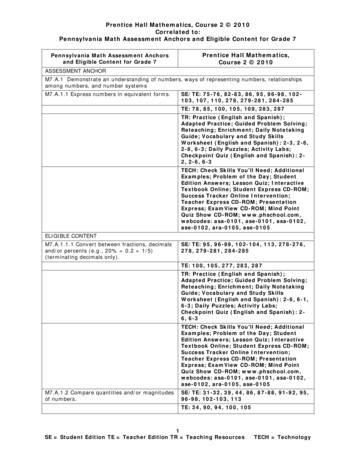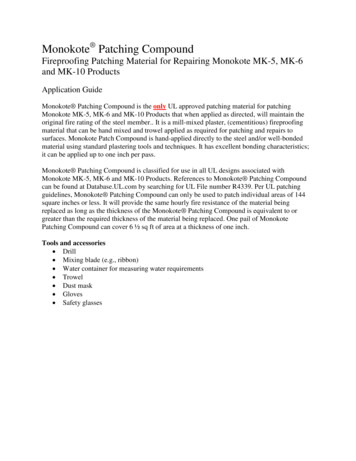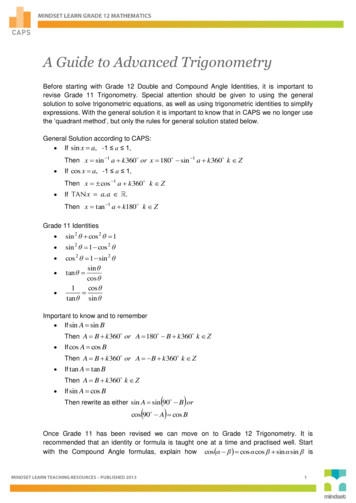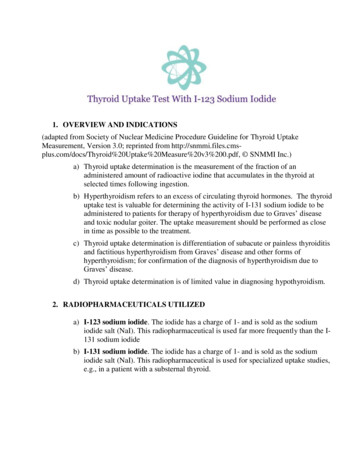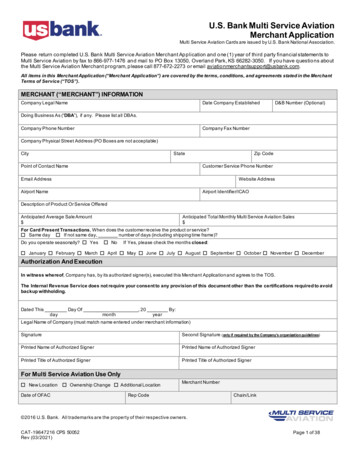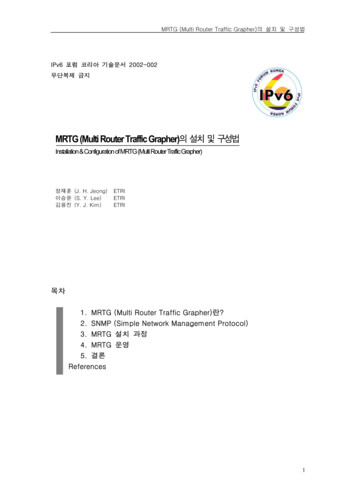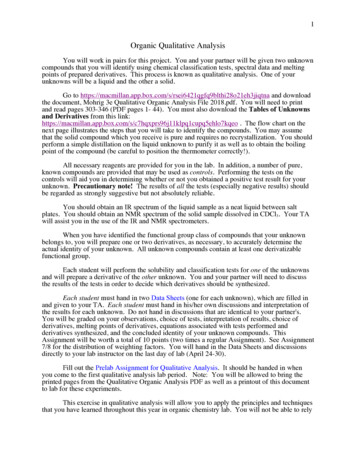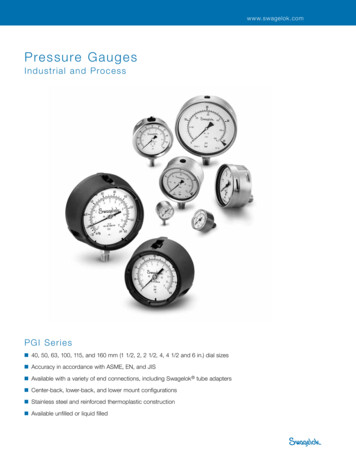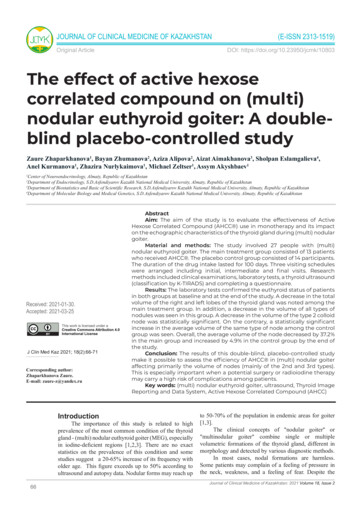
Transcription
JOURNAL OF CLINICAL MEDICINE OF KAZAKHSTANOriginal Article(E-ISSN 2313-1519)DOI: https://doi.org/10.23950/jcmk/10803The effect of aсtive hexosecorrelated compound on (multi)nodular euthyroid goiter: A doubleblind placebo-controlled studyZaure Zhaparkhanova1, Bayan Zhumanova2, Aziza Alipova2, Aizat Aimakhanova3, Sholpan Eslamgalieva4,Anel Kurmanova1, Zhazira Nurlykaimova1, Michael Zeltser1, Assym Akyshbaev1Center of Neuroendocrinology, Almaty, Republic of KazakhstanDepartment of Endocrinology, S.D.Asfendiyarov Kazakh National Medical University, Almaty, Republic of Kazakhstan3Department of Biostatistics and Basic of Scientific Research, S.D.Asfendiyarov Kazakh National Medical University, Almaty, Republic of Kazakhstan4Department of Molecular Biology and Medical Genetics, S.D.Asfendiyarov Kazakh National Medical University, Almaty, Republic of Kazakhstan12Received: 2021-01-30.Accepted: 2021-03-25J Clin Med Kaz 2021; 18(2):66-71Corresponding author:Zhaparkhanova Zaure.E-mail: zaure-z@yandex.ruIntroductionAbstractAim: The aim of the study is to evaluate the effectiveness of АctiveHexose Correlated Compound (АНСС ) use in monotherapy and its impacton the echographic characteristics of the thyroid gland during (multi) nodulargoiter.Material and methods: The study involved 27 people with (multi)nodular euthyroid goiter. The main treatment group consisted of 13 patientswho received АНСС . The placebo control group consisted of 14 participants.The duration of the drug intake lasted for 100 days. Three visiting scheduleswere arranged including initial, intermediate and final visits. Researchmethods included clinical examinations, laboratory tests, a thyroid ultrasound(classification by K-TIRADS) and completing a questionnaire.Results: The laboratory tests confirmed the euthyroid status of patientsin both groups at baseline and at the end of the study. A decrease in the totalvolume of the right and left lobes of the thyroid gland was noted among themain treatment group. In addition, a decrease in the volume of all types ofnodules was seen in this group. A decrease in the volume of the type 2 colloidnode was statistically significant. On the contrary, a statistically significantincrease in the average volume of the same type of node among the controlgroup was seen. Overall, the average volume of the node decreased by 37.2%in the main group and increased by 4.9% in the control group by the end ofthe study.Conclusion: The results of this double-blind, placebo-controlled studymake it possible to assess the efficiency of АНСС in (multi) nodular goiteraffecting primarily the volume of nodes (mainly of the 2nd and 3rd types).This is especially important when a potential surgery or radioiodine therapymay carry a high risk of complications among patients.Key words: (multi) nodular euthyroid goiter, ultrasound, Thyroid ImageReporting and Data System, Аctive Hexose Correlated Compound (АHCC)The importance of this study is related to highprevalence of the most common condition of the thyroidgland - (multi) nodular euthyroid goiter (MEG), especiallyin iodine-deficient regions [1,2,3]. There are no exactstatistics on the prevalence of this condition and somestudies suggest a 20-65% increase of its frequency witholder age. This figure exceeds up to 50% according toultrasound and autopsy data. Nodular forms may reach up66to 50-70% of the population in endemic areas for goiter[1,3].The clinical concepts of "nodular goiter" or"multinodular goiter" combine single or multiplevolumetric formations of the thyroid gland, different inmorphology and detected by various diagnostic methods.In most cases, nodal formations are harmless.Some patients may complain of a feeling of pressure inthe neck, weakness, and a feeling of fear. Despite theJournal of Clinical Medicine of Kazakhstan: 2021 Volume 18, Issue 2
seeming harmlessness, the thyroid nodes not only increase insize, causing compression of the surrounding organs, but alsomay lead to the formation of functional autonomy. In iodinedeficient regions, more often than in other territories, nodulargoiter (NG) can degenerate into malignant formations [1,3].The most common key method for diagnosing MEGand NG is a thyroid ultrasound, which allows to identifynodes from 2-3 mm. There are various methods of the thyroidgland visualization nowadays including TIRADS (ThyroidImage Reporting and Data System); first proposed in 2009by Horvath E. et al, subsequently modified by Kwak et al in2011 (K-TIRADS), the American College of Radiology (ACRTIRADS) and the European Thyroid Association (EU-TIRADS)[4,5,6]. According to Shi et al, the sensitivity of K-TIRADSis higher than that of ACR-TIRADS and EU-TIRADS, whileACR-TIRADS and EU-TIRADS have a higher specificity [6].The creation of these thyroid imaging systems is intended tohelp with the diagnosis of nodal formations estimating the riskof malignancy in each category [7].The treatment methods of MEG are inconclusive due todifferent approaches used in practice. The clinical significance ofnodal formations is essentially limited by the need of excludingthe oncological process. The treatment tactics of NG inaccordance with the protocol for diagnosis and treatment of NGin adults, adopted in the Republic of Kazakhstan, depends on theresults of fine-needle aspiration biopsy. In case of colloid goiter,an observation over the thyroid function and its size is required.In case of cancerous formations, a patient is usually referred toa different specialist [8]. At the same time, the commonly seengrowth of nodes is accompanied by a deterioration in the wellbeing of patients and abnormalities in thyroid function.A previously proposed TSH- suppressive therapy withlevothyroxine was prescribed to prevent further growth ofnodules in the thyroid gland by suppressing the secretion ofthyroid stimulating hormone (TSH). Currently, given the risksof the TSH-suppressive therapy, researchers recommend somerestrictions on its use [2,4,9]. To date, there are no methods ofinfluencing the actual formation of thyroid nodules that haveproven their effectiveness.Within the framework of the principles of integrativemedicine, the use of АНСС , a standardized extract of themushroom mycelium Lentinula edodes, produced by AminoUp(Japan), has become widespread. The АНСС has been used inmore than 45 countries for over 30 years. More than 100 studieshave been published on the results of its application in variousfields of medicine [10,11]. Considering the isolated studies onthe use of АНСС in thyroidology, it seems relevant to assessits effect on the course of NG and MEG.A double-blind, placebo-controlled study to assess theeffectiveness of АНСС in clinical management of NG andMEG in Kazakhstan was conducted for the first time.The aim of this study is to evaluate the effectivenessof АНСС in monotherapy and to assess its effect on theechographic characteristics of the thyroid gland during (multi)nodular goiter.Material and methodsThe study was conducted between February and June 2020.A total of 30 people were invited to participate in this study. Thepatients were randomly divided into two comparable groups.The control (placebo) group was prescribed the test food fromthe lot 1 (placebo). The intervention group was prescribedthe test food from lot 2 (АНСС ) at a dose of 3000 mg perday in the form of a food supplement registered in the RepublicJournal of Clinical Medicine of Kazakhstan: 2021 Volume 18, Issue 2of Kazakhstan, 1500 mg daily, twice a day before breakfast andbefore lunch. Neither the patient nor the investigator knew thecontents of both lots.The study was completed by 27 people. 3 people(suburbanites) dropped out of the study due to quarantinemeasures caused by the COVID 19 pandemic.The control group consisted of 14 patients (12 females and2 males) with an average age of 46.70 10.1 years. The treatment(or intervention) group consisted of 13 patients (11 females and2 males) with an average age of 49.85 12.5 years.Criteria for inclusion:1. Men and women 30-70 years old with a diagnosed NGor MEG2. Patients not taking medications, including iodinepreparations and thyroid hormones at the beginning and beforethe end of the study3. Patients who are able to adhere to the therapy regimenand follow the recommendations of the attending physician4. Patients who signed the informed consent to participatein the studyExclusion criteria:1. Patients with severe somatic, oncological, mentalillnesses2. Pregnant and breastfeeding women3. Patients under 30 and over 70 years old4. Patients participating in other studiesThe study was conducted at the Center forNeuroendocrinology, Almaty.The visiting schedule included three visits. A clinicalexaminations, filling out a questionnaire, blood analysis, anultrasound of the thyroid gland, prescription and dispensing ofthe test food from lot 1 or 2 were conducted during the initialvisit. At the second intermediate visit, a clinical examinationwas performed including a thyroid ultrasound and filling outthe questionnaires. The third final visit included a clinicalexamination, filling out the questionnaire, blood analysis, andultrasound of the thyroid gland. The average follow-up timebetween the first and second visit was 53.1 days, and betweenthe second interim and third final visit, 57.9 days. The totalduration of observation was 109.9 days in the control groupand 111.9 days in the treatment group. The lengthening of theobservation period was caused by quarantine measures, whichprevented the patients from getting to the study on time. Thesupply of test food from both lots and the duration of test foodintake were 100 days.The clinical examination included complaints andanamnesis, examination and assessment of clinical symptomsand a palpation of the thyroid gland at each visit. To assessthe degree of thyroid enlargement by palpation, the generallyaccepted WHO classification (2001) was used, according towhich 0, 1, and 2 degrees of enlargement were determined. Inaddition, the consistency of the node and its displacement wereassessed by palpation, and the lymph nodes of the neck wereexamined.Laboratory methods included determination of TSH,antibody titers to thyroglobulin (TgAb), antibody titers to thyroidperoxidase (TPOAb), free thyroxine (FT4) and calcitonin (CT)using solid phase chemiluminescence immunoassay.A thyroid ultrasound was performed three times (at 1, 2,and 3 visits). The volume of the thyroid was calculated using aformula that takes into account the width, length and thicknessof each lobe and the correction factor for ellipsoid. In addition,the ultrasound protocol included a description of the locationand size of thyroid gland lesions and lymph nodes, taking67
into account the ultrasound characteristics. The K-TIRADSclassification was used [5]. In all examined individuals, theultrasound characteristics of the thyroid gland correspondedto the TI-RADS 2 category, which is not typical for thyroidcancer. A stationary device for ultrasound diagnostics "Siemens"ACUSON X-700 was used. A VF-12-4 linear probe was used tostudy thyroid tissues.At each visit, all patients were asked to fill out aquestionnaire, which included the answer options about the stateof health based on 13 signs and measured on a 5-point scale. Aninformed consent was obtained from each patient.The study was approved by the Local Ethics Commissionof JSC "National Medical University" dated June 10, 2019,meeting No. 7 (84), (application No. 785)The data analysis was conducted on Excel. Descriptivestatistics was used for the quantitative parameters. If thedistribution of the data was close to normal (determined bythe Shapiro-Wilk test), then the comparison between the twoindicators was performed using the paired Student's t test,otherwise Wilcoxon test was used. To determine the significanceof the difference between the control and the main group,unpaired Student's t test was used for normally distributed data,otherwise the nonparametric Mann-Whitney test was used. ThePearson Chi-square test was used for analysis of categorical data.To form the database, we used software created with theMS Excel spreadsheet processor. Further statistical processingof the data was carried out using the SPSS 13.0 package. Twosided criteria at a significance level of α 0.05 was used for thestatistical analysis.ResultsMost of the patients did not present any complaints andsome of them developed non-specific symptoms. In some cases,discomfort in the neck area, an increase in its size, fatigue, andweakness was noted.In accordance with the research plan, we carried out acomparative assessment of the average values of the studiedlaboratory parameters. The data on laboratory analysis of patientsin the control and treatment groups are presented in Table 1.According to the results of laboratory tests, the initialeuthyroid status remained the entire observation period inpatients of both groups. To assess the echographic parametersin patients of both groups, the results of a thyroid ultrasoundwere analyzed. A comparison of such basic indicators as the totalvolume of the thyroid gland and the volume of its right and leftlobes was carried out and presented in Table 2.Table 1Laboratory tests results of both groups(average values)IndicatorsТSH (0,4-4,0 mIU/L)GroupsMainControlFТ4 (9,0-19,05 pmol/L) MainControlTGAb ( 18,0 IU /ml)MainControlTPOAb ( 5,6 /ml)MainControlCT ( 8,4 pg/ml)MainControl68Initial visit1,57 0,871,55 0,8412,64 1,8913,14 1,883,0 (3,0; 3,0)3,0 (3,0; 7,75)3,0 (3,0; 3,0)3,0 (3,0; 3,0)2,0 (2,0; 2,0)2,0 (2,0; 2,25)Final visit1,78 0,851,42 0,7511,99 1,1112,49 0,893,0 (3,0; 3,6)3,0 (3,0; 25,55)3,0 (3,0; 3,0)3,0 (3,0; 3,0)2,0 (2,0; 2,0)2,0 (2,0; 2,0)As it can be seen from the table, the studied parametersin treatment and control groups at the start of the study did notdiffer statistically. The initially larger thyroid volume in thecontrol group is explained by the inclusion in this group of apatient with an abnormal initial total thyroid volume of 130 cm3.Compliance of the patient's data with the inclusion criteria of thestudy allowed us considering the results of this specific patient’sdata. However, due to the extreme values, we also analyzed theresults without the outliers. Recommendations for the statisticalanalysis of medical data require the analysis to be performedtwice (with outliers and then without) [12,13]. At the initial visit,comparison of similar indicators of the treatment group with thecontrol group without outliers also did not reveal significantdifferences.At the second interim visit, the volume of the left lobeslightly increased in patients in the treatment group. In thecontrol group, the volume of the right lobe increased. In patientsof the control group without outliers, an increase in all studiedparameters was noted. The differences between the groupsremained insignificant.By the end of the study, all the study parameters in theintervention group decreased. There was also an increase in allthree indicators in the control group including the control groupwithout outliers. However, a statistically significant decreasein the main group was revealed in relation to a decrease in thevolume of only the left lobe (p 0.033). The dynamics of changesin the total volume of nodes is analyzed (Table 3).In the control group, the initial mean total volume of nodes,which amounted to 6.14 (6.08; 0.63) cm3, slightly increased atthe intermediate visit to 6.19 (0.45; 6.8) cm3 and reached 6.46by the end of the observation (0.4; 6.8) cm3. An increase in theaverage total volume of nodes from 3.09 (0.55; 3.9) cm3 to 3.25(0.4; 4.4) cm3 occurred in the control group without outliers.Only the main group showed positive dynamics. Theaverage volume of nodes in the main group, which initiallyamounted to 3.45 (2.7; 5.2) cm3, significantly decreased to 2.92(0.3; 4.75) cm3 at the intermediate visit and decreased evenmore by the end of observation to 2.17 (0.3; 4.5) cm3.During the indicated observation period, we analyzed theultrasound characteristics of various types of identified nodes type 1 colloidal nodes (CN1), Hashimoto type 1 pseudo-nodes(CNH), type 2 colloidal nodes (CN2), type 3 colloidal nodes(CN3) of the K-TIRADS2 category. The data on ultrasoundcharacteristics of the thyroid gland formations in the controlgroup are presented in Table 4.In patients of the control group, the largest volume fell ontypes CN2 and CN3. By the end of the study, all types of nodesretained their original volume. At the same time, the volume ofCN2 significantly increased from 1.2 (0.375; 3.825) cm3 to 1.75(0.825; 6.975) cm3 by the end of the observation (p 0.028). Thedecrease in the volumes of CNH and CN3 was not statisticallysignificant.In patients of the control group without outliers, a similarsignificantly significant (p 0.043) increase in CV2 was revealedfrom 1.1 (0.35; 1.85) to 1.5 (0.65; 4.4). The decrease in thevolume of CN3 and CNH was not statistically significant.In the main group, the largest initial volume also fell onthe types CN3 and CN2. There is an obvious tendency towards adecrease in the volume of all types of nodules. In particular, thevolume of CN1 decreased from 0.1 (0.0; 0.2) cm3 to 0.0 (0.0;0.1) cm3. The volume of CN2 significantly decreased by the endof the observation from 1.8 (0.6; 4.2) cm3 to 1.05 (0.325; 3.8)cm3. The volume of CN3 decreased by almost half, and by theend of the observation, CNH was not detected at all.Journal of Clinical Medicine of Kazakhstan: 2021 Volume 18, Issue 2
13,212,9(10,8; 24,4) (9,3;18,8)23р1-3 0,05 16,35р2-3 0,05 (14,1;35,58)115,9(13,3;28,3)13,0(10,75;17,15)р1-3 0,05 16,6р2-3 0,05 (13,03;36,4)16,4(12,35;31.55)13,3(11,0;16,05)р1-3 0,05р2-3 0,05Thevolumeof the leftlobeThevolume ofthe 5)р1-3 0,05 7,85р2-3 0,05 (5,73;14,88)7,3(5,65;13,9)4,9(3,7;9,4)р1-3 0,05 7,5р2-3 0,05 (5,7; 16,4)7,4(5,7;15,4)4,9(3,3; 9.25)р1-3 0,05р2-3 0,057,2(6,25; 8,5)р1-3 0,05 8,5р2-3 0,05 (6,0; 21,38)8,2(5,3;18,65)7,49 2,11р1-3 0,05р2-3 0,057,65(4,83;13,2)Table 37,27,94 (4,75; 10,9) 3,482р1-3 0,05 12,66 р2-3 0,05 9,1338,4(6,2; 14,1)1Initial visitIntermediate visitFinal visitControl group without outliers (n 13)1,3 (0,55; 3,9)1,3 (0,4; 4,6)1,5 (0,4; 4,4)11,3 (0,63; 6,08)Control group (n 14)Main (intervention) group (n 13)Table 4CNHCN2CN321,35 (0,45; 6,8)2,7 (0,7; 5,2)1,5 (0,6; 4,75)р31,75 (0,4; 6,98)р1-3 0,05р2-3 0,05р1-3 0,05р2-3 0,05р1-3 0,036р2-3 0,0211,1 (0,3; 4,5)Dynamics of changes in the volumes of various types of thyroid nodules at different periods of the study30,5(0,5;05)0,4(0,4;0,4)0,00,0(0,0;0,05) (0,0;0,0)1,2(0,375;3,825)1,2(0,5; 6,6)0,5(0,3;0,7)5,4(1,7;16,6)Р3-1 0,05р3-1 0,051,75р3-1 0,028(0,825;6,975)8,22,0(1,7;14,7) (0,4;16,1)р3-1 7;16,6)8,22,0Р3-1 0,05(1,7;14,7) (0,4;16,1)Main (intervention) group (n 13)p12Final visitFinal visit20,0(0,0;0,0)1,11,11,5Р3-1 0,043(0,35;1,85) (0,45;3,6) (0,65;4,4)Table 5 shows the results of the survey, in which the patientsof the control and main groups self- assessed health accordingto a 5-point system. For statistical processing, the Pearson Chisquare test was used. The following indicators were assessed:appetite, weakness, mood, palpitations, constipation or diarrhea,tension in the eyes, a tendency to infections, ringing in the ears,dry skin, headaches, malaise and neck circumference.In the main group, significant (p 0.026) improvementwas noted for such a sign as palpitation. At the final visit,10 participants (76.92%) noted this sign by 4 and 5 points inthe main group, and only 2 participants in the control group(14.28%). Other 3 patients of the main group (23.08%) and 10Journal of Clinical Medicine of Kazakhstan: 2021 Volume 18, Issue 2IntermediatevisitControl group without outliers (n 13)pInitial visitFinal visitInitial visitControl group (n 14)Initial visitCN13Average volume of nodes (cm3) during the study periodGroupsIndicators(cm3)2Main(intervention)(n 13)13,9(11,0;31,43)Control group(n 14)Control group(n 14)pTotalthyroidvolume1Main(intervention)(n 13)Final visitpMain(intervention)(n 13)Control groupwithout outliers(n 13)Intermediate visitрControl groupwithout outliers(n 13)Con trol group(n 14)Indicators Initial visit(cm3)Control groupwithout outliers(n 13)Comparison of the thyroid gland parameters between groups of patients at different periods of the studyTable 230,10,00,0(0,0;0,2) (0,0;0,2) (0,0;0,1)Р3-1 0,051,81,51,05(0,6;4,2) (0,6;4,6) (0,325;3,8)Р2-3 0,021Р1-3 0,0370,1(0,1;0,1)-6,454,93,4(5,4;7,5) (4,9;4,9) (3,4;3,4)Р3-1 0,05participants (71.44%) of the control group rated this sign at 3points.In the main group, there was also statistically significantimprovement (p 0.014) in terms of headaches: 9 participantsof the main group (69.23%) noted this feature at 4 and 5points, while in the control - only 2 people (14.28%) reportedthe improvement. Other 4 participants (30.77%) of the maingroup and 8 participants (57.15%) of the control group noted asatisfactory state on this basis.Statistically significant (p 0.015) improvement in themain group was also revealed for such a sign as ringing inthe ears (tinnitus): 10 participants in the main (76.92%) and 369
Table Survey results by the end of the studyGroupsControl(n 14)Main(n 13)Control(n 14)Main(n 13)Control(n 14)Main(n 13)Control(n 14)Main(n 13)Scores (n%)11 (7,14)-------21 (7,14)-4 (28,57)----2 (15,38)participants in the control group (21.42%) assessed this featureat 4 and 5 points by the end of the observation. This featurewas assessed as satisfactory by 3 participants in the main group(23.08%) and 11 participants (78.58%) in the control group.According to such a sign as the nature of the stool (thepresence of constipation), a significantly significant (p 0.001)improvement was also revealed by the end of observation inthe main group: 10 participants (76.92%) noted this feature at 4and 5 points, while in the control - only 2 (14.28%) participantsreported the improvement; 1 participant (7.7%) of the maingroup and 12 participants (85.72%) of the control group ratedthis feature as satisfactory.According to the other 9 signs, by the end of the observation,there was a tendency towards improvement in the condition inthe patients of the main group, but not statistically significantdifference with the control group was revealed.DiscussionThe number of patients with NG and MEG in endemicregions tends to grow. The territory of Kazakhstan is an endemiczone for iodine deficiency. The search for more advancedtreatment methods of NG and MEG in iodine-deficient regionsis an urgent task due to the existing methods being not effectiveenough. The results of this double-blind, placebo-controlledstudy were obtained by comparing homogeneous by number ofobservations, age and gender groups.In both groups, the diagnosis was made in accordance withthe protocol for the diagnosis and treatment of NG, adopted inthe Republic of Kazakhstan [8]. The diagnosis of each patientincluded in the study met the required criteria.An evaluation of clinical symptoms, carried out at eachexamination, indicated the euthyroid status of patients in bothgroups throughout the study period. The main part consisted ofpatients with a degree 1 thyroid enlargement. To a lesser extent with normal volume and a grade 2 thyroid enlargement. In somepatients, the consistency of the nodes and their displacementwere assessed by palpation.The laboratory data confirmed the euthyroid status ofpatients in both groups, both at baseline and at the end. The CTcontent, which was within the reference values for the entireobservation period, indirectly indicated a low probability ofthyroid cancer in all patients. The ultrasound characteristicscorresponded to the K-TIRADS2 category, which is not acharacteristic of thyroid cancer.70310 (71,44)3 (23,08)8 (57,15)4 (30,77)11 (78,58)3 (23,08)12 (85,72)1 (7,7)41 (7,14)5 (38,46)2 (14,28)5 (38,46)1 (7,14)4 (30,77)1 (7,14)7 (53,84)p51 (7,14)р 0,026-р 0,0142 (14,28)р 0,0151 (7,14)р 0,0015 (38,46)4 (30,77)6 (46,15)3 (23,08)By the end of the entire observation period, in the maintreatment group, there was a slight decrease not only in the totalvolume, but also in both thyroid lobes. In the control group, onthe contrary, there was an increase in the total volume of thethyroid gland and its right lobe. In the control group, withouttaking into account the outliers, an increase was noted not onlyin the total volume, but also in both of its shares. However,when comparing the indicators, a statistically significantdecrease in the main group was revealed in relation to a decreasein the volume of only the left lobe (p 0.033). We revealed astatistically significant decrease in the average volume of nodesin the main treatment group from 3.45 (2.7; 5.2) cm3 to 2.17(0.3; 4.5) cm3 by the end of the observation, as an evidence ofАНСС ’s positive effect.There are no generally accepted criteria for evaluatingthe growth or shrinkage of a node using ultrasound. There isno agreement on how to define significant growth or reductionof nodes. The American Thyroid Association guidelines suggestthat growth be defined as an increase in two of the three nodesizes by at least 20% with a minimum increase in area of at least2 mm2. Such criteria correspond to an increase in the volume ofthe node by at least 44%, which allows one to estimate the realchange in size [14].We revealed a statistically significant decrease in theaverage volume of nodes from 3.45 (2.7; 5.2) cm3 to 2.17(0.3;4.5) cm3 by the end of the study, which amounted to 37.2%and may indicate a significant positive effect of this test food. Incontrast, taking placebo resulted in a 4.9% increase in mean totalnodule volume. In a study by Grussendorf M. et al [15], even thecombined use of L-thyroxine and iodide reduced the volume ofnodes by only 21.6%. In monotherapy with L-thyroxine, therewas a decrease in the volume of nodes by 12.6%, with iodide by 9%. Baldini M. [16] et al reported a decrease in the volumeof nodes on monotherapy with L-thyroxine by more than 30% inonly 26% of patients, no changes in 67% of patients, an increasein the size or the appearance of new nodes in 7% of treatedpatients.Ultrasound allows to determine not only the volume ofnodes, but also to identify their characteristics. It is generallyaccepted that the most effective use of five (TIRADS1TIRADS5) standard categories of conclusions of the internationalclassification K-TIRADS.According to the classification, category K-TIRADS2includes benign changes. The various echo-morphological typesJournal of Clinical Medicine of Kazakhstan: 2021 Volume 18, Issue 2
of nodes in this category include CN1, CNH, CN2 and CN3. Inaccordance with this, an assessment of thyroid ultrasound wascarried out among this study participants.According to the results of our study, a decrease inthe volume of all types of nodules was revealed in the main(intervention) group. At the same time, a decrease in the volumeof CN2 was also statistically significant. On the contrary, in thecontrol group, the volume of CN2 significantly increased by theend of the study.The general trend for all 27 patients of both groups is animprovement in their well-being, a decrease in the number ofunsatisfactory assessments. It is also possible that an increasein the "excellent" scores is due to the "placebo" effect in thecontrol group. This phenomenon shows that a placebo, which apatient takes for a drug, has a positive effect in about a third ofpatients in the study [12]. However, the best effect according tothe survey data on the well-being of patients was provided bytaking АНСС . Signs such as palpitations, headaches, ringingin the ears, constipation showed a significantly significantimprovement in patients of the main group in comparison withthe control group.All patients who received AHCC noted an increase inperformance, a decrease in neck circumference, a normalizationof blood pressure, a low susceptibility to respiratory diseases,and a decrease in weakness. No undesirable side effects wereobserved in any group of patients who completed the study inany case.ConclusionThis double-blind, placebo-controlled study allowedobtaining results that indicate the possibility of increasing theeffectiveness of treatments for patients with NG and MEG.АНСС is known to have a wide range of effects on theimmune system. It has been found to have a significant effecton the survival rate of patients with lung cancer, bladder cancerand melanoma [10]. The antitumor effect of АНСС may bepartially mediated by modulation of T-cell function. The effect ofАНСС in multinodular goiter, including on the immune systemin this disease, has not been studied. More research is needed toinvestigate the immunological effects and mechanisms that maylead to a deeper understanding of the mechanism of action ofАНСС in (multi) nodular euthyroid goiter. This clinical studycan be considered as preliminary and further supplemented by alarge number of observations and experimental studies.Thus, according to the results of this double-blind, placebocontrolled study, it can be noted that the use of АНСС iseffective and can be recommended for the treatment of NG andMEG. The drug has shown high efficiency in terms the volumesof nodes. This is especially important when possible surgeryor radioiodine therapy may carry a high risk of complicationsamong patients.Disclosures: There is no conflict of interest for all authors.Acknowledgements: None.Funding: Sponsor of the study: Amino Up Co., Ltd 15.16.Balabolkin M.I., Klebanova E.M., Kreminskaja V.M. Fundamental'naja i klinicheskaja tiroidologija (Fundamental and ClinicalThyroidology) [in Russian] М, 2007. 816 p.Valdina E.A. Zabolevanija shhitovidnoj zhelezy: Rukovodstvo (Thyroid Disorders: A Guide) [in Russian]. 3th ed. Spb, 20
peroxidase (TPOAb), free thyroxine (FT4) and calcitonin (CT) using solid phase chemiluminescence immunoassay. A thyroid ultrasound was performed three times (at 1, 2, and 3 visits). The volume of the thyroid was calculated using a formula that takes into account the width, length and thickn
